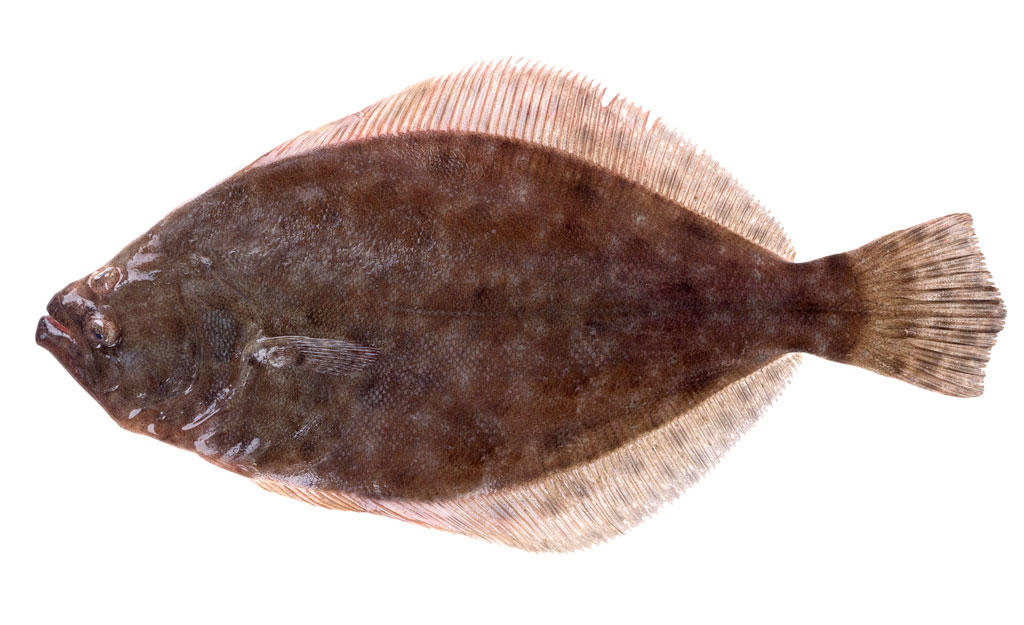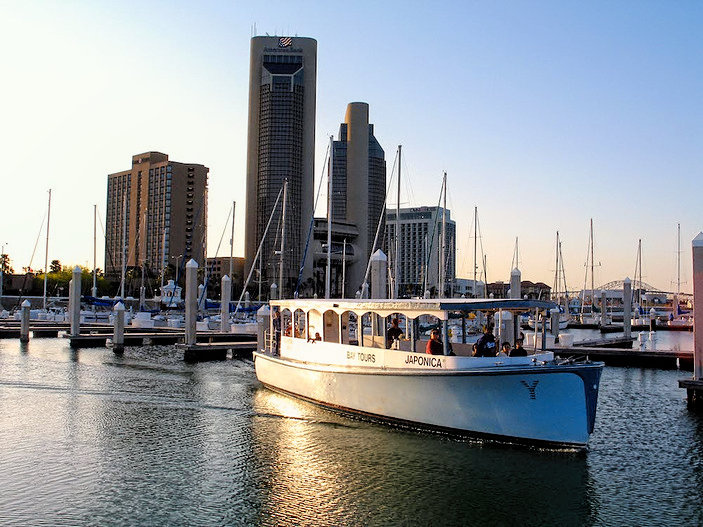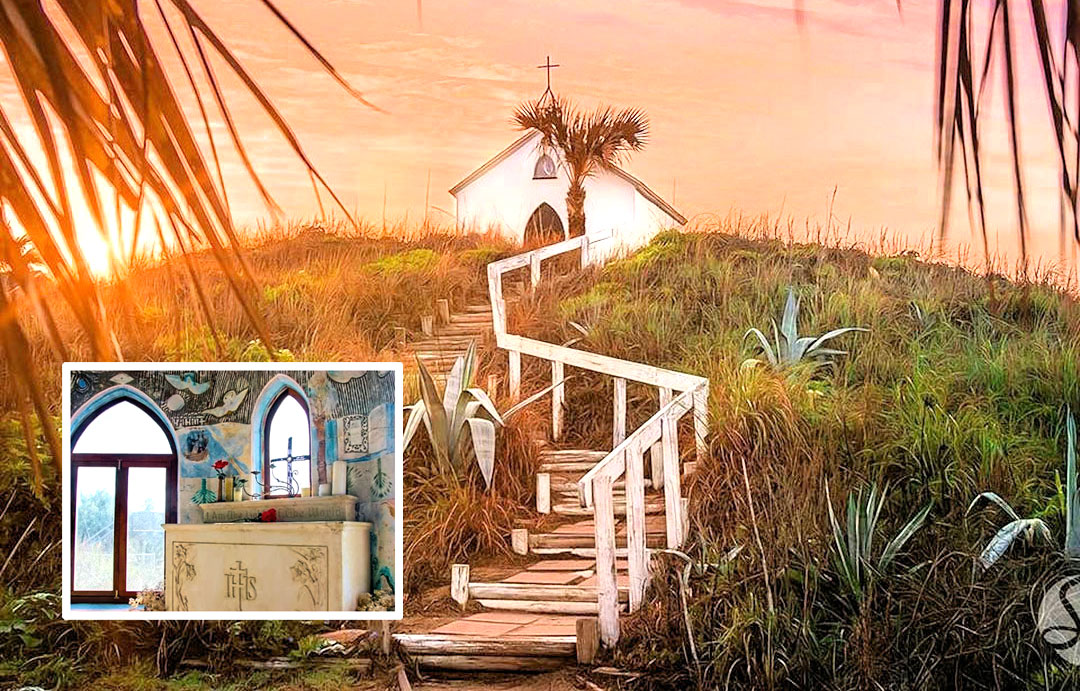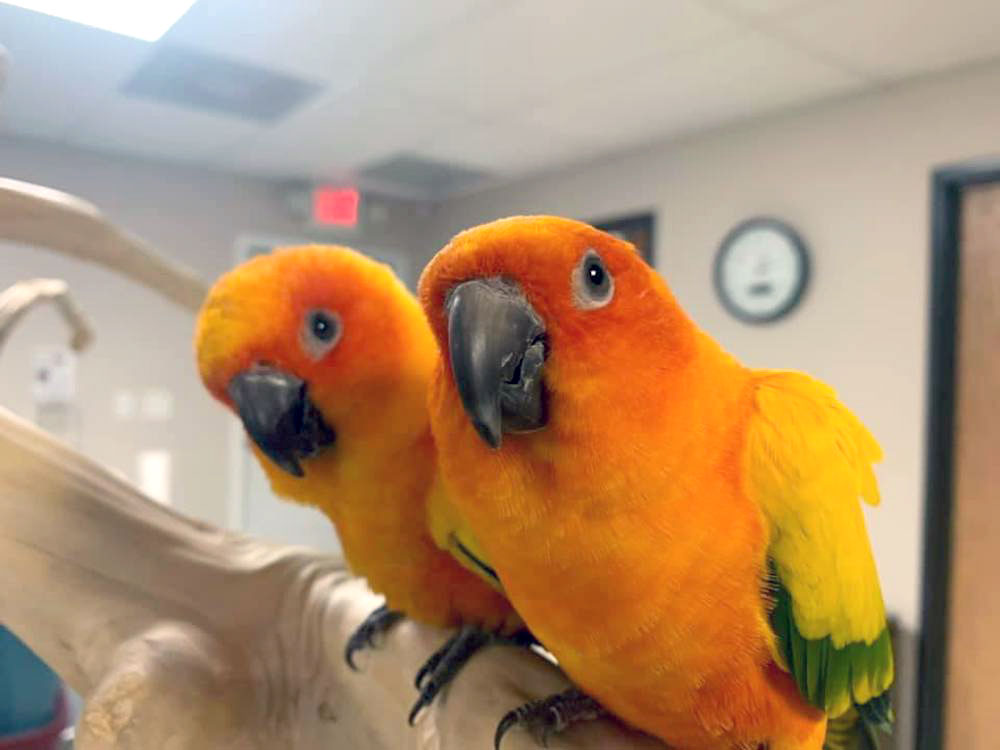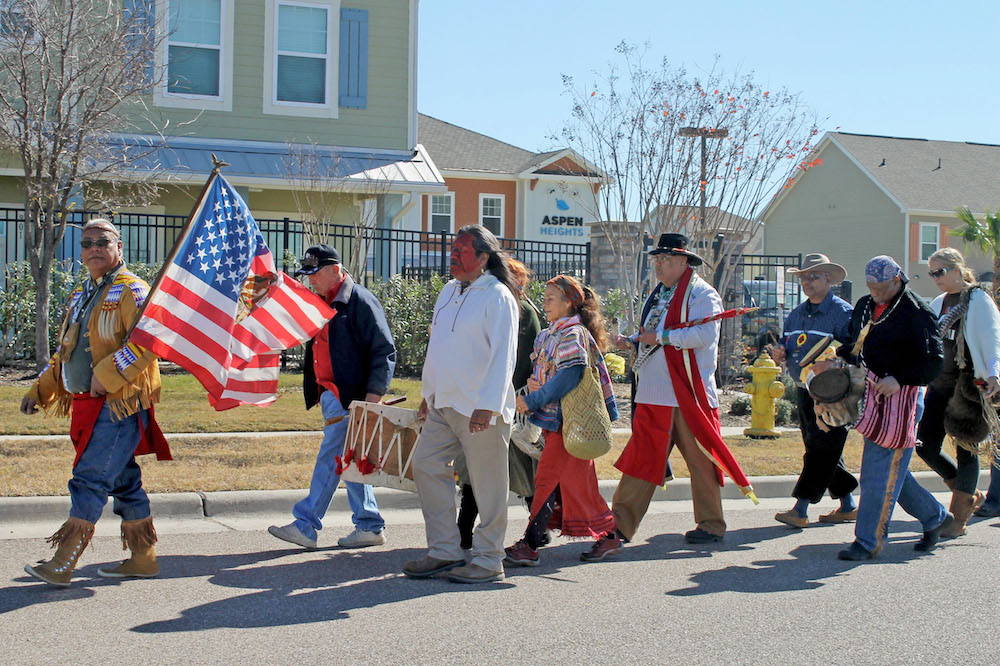
Members of the South Texas Alliance of Indigenous People march along Ennis-Joslin Road in Corpus Christi on Jan. 13. The annual procession honors the Native Americans who were buried there over the past 2,000 years. The area is the second-largest burial ground in Texas. Photo by Chris deLong
Marching to the beat of native drums as the smoke from sage smudge sticks drifts through the air, members of the South Texas Alliance of Indigenous People converge on a concrete medicine wheel on Ennis-Joslin Road. They gather in Corpus Christi to bless a sacred burial ground at least 2,000 years old.
Larry Running Turtle Salazar sprinkles tobacco, cedar and sweet grass over the area, chanting, praying and singing. It is his way of paying penance to the people who were dug up from this land in the last century to make way for housing and roads.
The place is known by archeologists as 41NU2, meaning the site is in the state of Texas (41), in Nueces County (NU), and is the second-largest burial ground in the state (2). To the general public, it is known as Pat and Hans Sutter Park on Ennis-Joslin, a four-lane stretch of asphalt that ends at Ocean Drive and a major artery to the Texas A&M University-Corpus Christi campus and Naval Air Station-Corpus Christi. It is also a sacred site for Native Americans.
The alliance plans to erect a monument at Sutter Park to serve as a tribute to Native American ancestors whose graves have been desecrated both locally and across the Americas. The group seeks to raise $300,000 to build the Ishka Monument, which was designed by the late sculptor Dave McGary.
A legendary contemporary artist of the American West, McGary is known for his bronze realism. The prototype, which was cast before McGary’s death, will be used to create the actual statue with the help of McGary’s widow.
Salazar has held a blessing ceremony at this site every year since 1994, when he first learned Native American bodies had been found there. An archeologist from the Texas Department of Transportation found the bones of what he believed were a 13-year-old girl. Salazar said a reporter from the local paper told him about the find and that the bones were believed to be 500 years old.
“I went out there to pay my respects and to do my ceremonies for forgiveness for what they were doing,” Salazar said. “(TxDOT workers) ran me out of there. I went back at midnight and was right there by the park singing my songs and praying, and the voices of the winds came in. I apologized for what was going on.”
That’s when he made the promise he keeps to this day.
“For as long as I am on this Earth Walk,” he said, “I will bless the grounds every single year on the date or close to the date I was notified that it was a burial ground.”
Salazar might not have known about the burial grounds until 1994, but TxDOT has known since 1933, when a hurricane unearthed 150 bodies at the site. That’s all common knowledge now thanks to a book written by an archeologist who worked the dig in 1996.
In his book, “The Karankawa Indians of Texas,” Robert Ricklis unfolds the story of these native people from prehistoric times to their extinction in the 1800s. According to his research, the bodies unearthed at 41NU2 are too old to be Karankawa.
“People have been living in (the Coastal Bend) for fourteen thousand years,” Ricklis said. “As far as identifying Karankawa, we can only push that back in time about one thousand years.”
Ricklis acknowledged that his understanding and interest in the site differ greatly from Salazar’s.
“I don’t attribute a belief system to my perspective,” he said. “My perspective is scientific and historical. The more we understand about the past, the more we understand the present.”
To that end, the bones found at the site have been studied by researchers at the University of Texas at Austin, where they remain. Ricklis said he respects Salazar’s concerns but what archeologists and other scientists are doing with the bones is a kind of respect, too.
“Of course, I respect (the bones),” he said. “We work with great care to be as sensitive as we can, to do as little damage as we can and study with as much analytical impartiality as we can to recreate the past. They say we should not touch these sites. If we don’t touch them, we would never learn from them.”
Salazar said the bones are being kept in shoe boxes and have been studied enough. He wants them back in the earth where they can be honored and remembered.
When asked why it matters for today’s people to honor those of centuries ago, Salazar has an apt rejoinder: “Why would it not?”
“What does it matter for people to honor those who are buried in Arlington National Cemetery?” he asked. “Those were warriors who fought for their country, for their lands. Just as it matters to honor them, it matters to the indigenous peoples to honor their own.”
Salazar, who is of Tsalagi and Apache descent, tells a harrowing story of growing up as a Native American child in Corpus Christi. He began his public education in the first grade at Chula Vista Elementary School, where he was taken to the principal’s office to have his long hair cut off.
“They took away my medicine bag and told me I could only speak English,” he said. “I knew four languages. We were not allowed to bring our own food. We had to eat in the cafeteria. They stripped us from our identity when we were young.”
His mother kept their cultural identities alive after school, teaching him and his siblings the oral traditions, songs, stories and language.
Both Ricklis and Salazar tell of how similar acculturation affected the Karankawa and other Native Americans in the 1830s, when the Spanish colonial system collapsed.
“The Spanish wanted to convert them to Christianity,” Ricklis said. “The Anglo-Americans wanted to exterminate them and get them out of the way because they wanted their land.”
According to Salazar, many Native Americans cut their hair and adopted Hispanic names to pass as Mexican, which is where he gets his last name.
“My people took on Hispanic survival names,” he said. “They learned the language and the culture. They became Mexicano to stay alive.”
The spiritualist and the scientist agree on something else important about the Karankawas: They were not cannibals as often reported. Their economy was based on hunting, gathering and fishing. They were family-oriented and welcoming to outsiders.
Another difference arises, however, when it comes to building a monument at Sutter Park: Where Ricklis is ambivalent, Salazar is passionate.
According to Ricklis, neither the medicine wheel nor the monument are Karankawa; they are part of the Plains Indian culture.
“The general tendency is to put everything under an umbrella of common perception of Native Americans, “ he said. “That’s not what we do in archeology. We have to determine the differences between the cultures. To put it together under one Native American, that’s not fair to the Karankawa.”
Salazar said what matters most is the connection people feel to their cultural backgrounds. He noted a recent interest in people having their DNA tested to track their ancestry.
“A lot of people are finding out they are at least part Native American,” he said. “Before, when people were changing their names, they didn’t talk about it to their children or grandchildren; they hid it. Now, seventh–generation children are finding out about it and want to be proud of it.”
Not everyone who marches with Salazar around the medicine wheel in Sutter Park each winter is Native American — at least as far as they know. They come to pay their respects and apologize for the horrific treatment handed down to America’s indigenous peoples over the centuries.
“It’s not a protest,” Salazar said. “It’s not a parade. It’s a funeral procession, and we do it every single year. We have done it since 1994, and we will continue to do it.”

